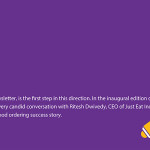1. From Hungry Bangalore to Hungry Zone to JustEat to now being part of Foodpanda, how would you summarize the journey? Could you share some of your key learnings, especially in managing transitions and scaling business?
The journey so far has been nothing short of amazing. JustEat, which began in 2006, was earlier known as Hungry Bangalore. It was founded on the idea that if a consumer could book tickets online, find a soulmate online, buy apparel, and electronic goods online, then why not order food online and from within the comfort of their home? It was this simple thought of offering convenience in online food ordering which made us embark on a mission to change the way India orders food. We have grown from a partnership of just 400 restaurants in 2008 to over 3,000 restaurants in the last few years. Post the Foodpanda acquisition, we have expanded our footprint across the country, with a combined entity that is present in 200 cities in India and has over 12,000 restaurants on board.Though the last nine years have been a mixed bag of ups and downs, we have got to where we are today because we believe perseverance is the key. If you have good, hardworking people on board, success is within reach. As far as scaling up the business is concerned, we are taking a measured approach to integrate the functions at all three companies (Foodpanda, Tastykhana, and JustEat). Though there is an overlap of products, markets, and customers, each company has its strengths, and that is what we are working on integrating. The process of transition is underway and has been smooth enough to ensure the creation of a global online food takeaway group. We aim to further strengthen our position as the largest online and mobile food ordering service in India.
2. What are the key operational and technology challenges in the online food ordering business, especially in the Indian context,how did you overcome them?
Our greatest challenge was to bring delivery restaurants into the 21st Century. That means getting them to embrace technology, understand the importance of on-time delivery and great customer service. In an industry where 1 in 6 restaurants go out of business within the first year, we want to support them in many ways, and not just by giving them orders. Secondly, getting customers accustomed to online food ordering was a challenge. People are used to
ordering food on the phone. But we wanted to change that by providing a rich and smooth ordering experience. We only have 30-60 to minutes to get the food to the customer, which means we have to be operationally efficient to achieve this.
3. How has the technology adoption by restaurants changed over a period of time?
Restaurants have been slow adopters of technology, but a few of them are breaking this norm. While some restaurants today have tablet-based menus where customers can pick out the dishes they want rather than read through 4-5 pages of a menu card. Few others such as fast food restaurants have digital menu boards that help them change menus and prices much easier than manually changing prices and items. From the delivery point of view, we have seen more and more restaurants enabling mobile ordering. There has also been an increase in the usage of ePOS systems and online delivering which gives them incremental business when compared to dine-ins.
4. How does it differ to serve a customer on mobile vis-a-vis web? How do you get more users to download your mobile app?
Mobile is rapidly becoming a preferred choice for consumers for its ease. We have seen youngsters increasingly spend more time on their phones than on their desktops. Our observation is that bachelors and young couples between the ages of 25-35 make about 79% of their orders on JustEat mobile apps. Another interesting trend to note is that in while January 2014, our mobile orders were 3o% of overall orders, as of January 2015, it’s close to 70%. We run affiliate campaigns for app promotions, send out SMSes, and mailers. We offer app-only discounts and even do social media promotions.
5. What are your key monetization models?
Our monetization model has three parts to it
(a) Commission from restaurants on the order volume
(b) Sign-up fee from restaurants, and
(c) Revenues from advertising
6. How big is the online food ordering market in India? How are you gearing up for the next phase of growth?
In India, the online food services market is valued at over $14 billion. We believe our partnership withFoodpanda will help us provide an even better service to our customers in India. Together with TastyKhana and FoodPanda, we will now be present in over 200 cities and partners with over 12,000 restaurants.
7. We are seeing lot of new start-ups in the food space, be it healthy nutrition or hyper-local deliveries.How do you see this space evolving in the near future?
Yes, there has been a surge of new entrants in this space and, at the moment, there is tremendous growth potential. We think that smaller players may choose a partnership model with bigger players a way of countering competition. There will also be immense focus on mobile-first strategy as more and more consumers are ordering on mobile, which accounts to about 70% of the orders.
8. What advice would you like to give others who are starting to either build an online business ground up or taking their brick and mortar businesses online?
Starting an online business today has huge growth potential as the e-commerce industry is one of the fastest growing sectors in the country. Therefore, it’s a must to build a good team that complements each other and not have friends on board just because they are good people. One must have a clear leadership and conflict-management method planned from day one. There is absolute need to bring good investors on board, i.e. people who have a clear understanding of the business needs and who support the founders through difficult phases.Get those with a never give up attitude on board. If the current idea doesn’t make sense,never feel shy of pivoting. Lastly, one must settle for a great product and market it accordingly, finding the best model to grow revenues faster.
9. Could you provide a list of funding received and acquisitions so far?
The initial fund that we received from the Indian Angel Network helped us expand to other cities set up a strong foothold in these cities, and in scaling our business further. A significant development occurred on 17 January, 2011 when we announced our partnership with JustEat. In November 2013, we raised a third round of investment from Indiabased value-added private equity fund manager Forum Synergies, renowned global investment company Axon Partners Group, and JustEat Holdings. And now as you know, in January 2015, we are part of the Foodpanda family.






No Comments